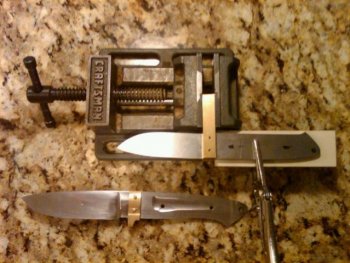Shane Justice
Active Member
This is my first time to actually post a question for how-to advice.
Not because I know everything, but because I rarely build full tang knives.
This one sort of grew that way as I was forging it. As it sometimes goes the tang has a slight taper to it when all was done.
The problem is, I did not account for having to drill holes for bolsters and handle slabs.
I am not sure how to make sure the holes are straight when I go to pin it all together.
Like I said, I am in new territory here.
I was thinking that I should just grind it down and make it into a stick tang, but I don't want to miss a chance to try something new.
Where can I go from here?
Shane
Not because I know everything, but because I rarely build full tang knives.
This one sort of grew that way as I was forging it. As it sometimes goes the tang has a slight taper to it when all was done.
The problem is, I did not account for having to drill holes for bolsters and handle slabs.
I am not sure how to make sure the holes are straight when I go to pin it all together.
Like I said, I am in new territory here.
I was thinking that I should just grind it down and make it into a stick tang, but I don't want to miss a chance to try something new.
Where can I go from here?
Shane

